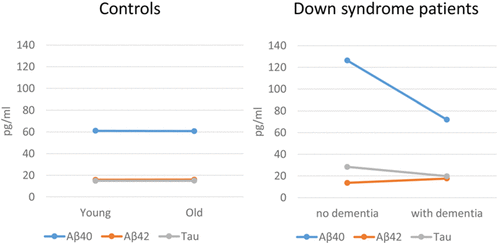当前位置:
X-MOL 学术
›
ACS Chem. Neurosci.
›
论文详情
Our official English website, www.x-mol.net, welcomes your feedback! (Note: you will need to create a separate account there.)
Composite Scores of Plasma Tau and β-Amyloids Correlate with Dementia in Down Syndrome.
ACS Chemical Neuroscience ( IF 5 ) Pub Date : 2019-12-23 , DOI: 10.1021/acschemneuro.9b00585 Wei-Quan Fang,Wuh-Liang Hwu,Yin-Hsiu Chien,Shieh-Yueh Yang,Jen-Jie Chieh,Lih-Maan Chang,Ai-Chu Huang,Ni-Chung Lee,Ming-Jang Chiu
ACS Chemical Neuroscience ( IF 5 ) Pub Date : 2019-12-23 , DOI: 10.1021/acschemneuro.9b00585 Wei-Quan Fang,Wuh-Liang Hwu,Yin-Hsiu Chien,Shieh-Yueh Yang,Jen-Jie Chieh,Lih-Maan Chang,Ai-Chu Huang,Ni-Chung Lee,Ming-Jang Chiu

|
Dementia frequently occurs in Down syndrome (DS) patients, and early intervention is important in its management. We have previously demonstrated a positive correlation of plasma β-amyloid Aβ42 levels and negative correlations of Aβ40 and tau levels with dementia in DS. In this study, we examined more cases and constructed composite scores with both tau and amyloids to correlate with dementia in DS. Plasma Aβ42, Aβ40, and tau proteins were measured by an immunomagnetic reduction assay in DS patients. Data were randomly and repeatedly split into training and validating sets, and logistic regression was applied to calculate the area under the curve (AUC) for each biomarker. A total of 73 DS patients (among them, 23 had neurodegeneration) and 77 controls were recruited. In DS patients without dementia, plasma Aβ40 and tau levels were highly elevated, but Aβ42 levels were lower than those of the healthy controls. DS patients with dementia, compared with DS patients with no dementia, had a large decline in Aβ40 and tau but a rise in Aβ42. For biomarker scores correlating with dementia, Aβ40 revealed an AUC of 0.912; the composite score of Aβ40 × tau revealed an AUC of 0.953; and a combined composite score of 0.1 for Aβ40 × Tau +0.9 Tau × Aβ40/Aβ42 achieved the highest AUC of 0.965. Therefore, composite biomarker scores including both plasma tau and β-amyloid levels correlate with dementia in DS better than using individual biomarker scores. The pattern of tau decline and Aβ42 rise in DS patients with dementia are also different from previous findings in Alzheimer's disease.
中文翻译:

唐氏综合症中血浆Tau和β-淀粉样蛋白的综合评分与痴呆症相关。
痴呆症常发生在唐氏综合症(DS)患者中,早期干预对其管理很重要。我们先前已证明DS中血浆β-淀粉样蛋白Aβ42水平呈正相关,而Aβ40和tau水平与痴呆呈负相关。在这项研究中,我们检查了更多病例,并建立了tau和淀粉样蛋白的综合评分,以与DS中的痴呆症相关。通过免疫磁化还原法测定DS患者的血浆Aβ42,Aβ40和tau蛋白。将数据随机重复地分成训练和验证集,然后应用逻辑回归来计算每种生物标记物的曲线下面积(AUC)。总共招募了73名DS患者(其中23名患有神经变性)和77名对照。在没有痴呆症的DS患者中,血浆Aβ40和tau水平显着升高,但Aβ42水平低于健康对照组。与没有痴呆的DS患者相比,患有痴呆的DS患者的Aβ40和tau下降较大,但Aβ42升高。对于与痴呆症相关的生物标志物得分,Aβ40的AUC为0.912。Aβ40×tau的综合得分显示AUC为0.953;Aβ40×Tau +0.9 Tau×Aβ40/Aβ42的综合得分为0.1,最高AUC为0.965。因此,包括血浆tau和β-淀粉样蛋白水平在内的复合生物标志物评分与DS中痴呆的相关性比使用单个生物标志物评分更好。DS痴呆患者中tau下降和Aβ42上升的模式也与先前在阿尔茨海默氏病中的发现不同。与没有痴呆的DS患者相比,Aβ40和tau下降较大,而Aβ42上升。对于与痴呆症相关的生物标志物得分,Aβ40的AUC为0.912。Aβ40×tau的综合得分显示AUC为0.953;Aβ40×Tau +0.9 Tau×Aβ40/Aβ42的综合得分为0.1,最高AUC为0.965。因此,包括血浆tau和β-淀粉样蛋白水平在内的复合生物标志物评分与DS中痴呆的相关性比使用单个生物标志物评分更好。DS痴呆患者中tau下降和Aβ42上升的模式也与先前在阿尔茨海默氏病中的发现不同。与没有痴呆的DS患者相比,Aβ40和tau下降较大,而Aβ42上升。对于与痴呆症相关的生物标志物得分,Aβ40的AUC为0.912。Aβ40×tau的综合得分显示AUC为0.953;Aβ40×Tau +0.9 Tau×Aβ40/Aβ42的综合得分为0.1,最高AUC为0.965。因此,包括血浆tau和β-淀粉样蛋白水平在内的复合生物标志物评分与DS中痴呆的相关性比使用单个生物标志物评分更好。DS痴呆患者中tau下降和Aβ42上升的模式也与先前在阿尔茨海默氏病中的发现不同。Aβ40×Tau +0.9 Tau×Aβ40/Aβ42的综合得分为0.1,最高AUC为0.965。因此,包括血浆tau和β-淀粉样蛋白水平在内的复合生物标志物评分与DS中痴呆的相关性比使用单个生物标志物评分更好。DS痴呆患者中tau下降和Aβ42上升的模式也与先前在阿尔茨海默氏病中的发现不同。Aβ40×Tau +0.9 Tau×Aβ40/Aβ42的综合得分为0.1,最高AUC为0.965。因此,包括血浆tau和β-淀粉样蛋白水平在内的复合生物标志物评分与DS中痴呆的相关性比使用单个生物标志物评分更好。DS痴呆患者中tau下降和Aβ42上升的模式也与先前在阿尔茨海默氏病中的发现不同。
更新日期:2019-12-25
中文翻译:

唐氏综合症中血浆Tau和β-淀粉样蛋白的综合评分与痴呆症相关。
痴呆症常发生在唐氏综合症(DS)患者中,早期干预对其管理很重要。我们先前已证明DS中血浆β-淀粉样蛋白Aβ42水平呈正相关,而Aβ40和tau水平与痴呆呈负相关。在这项研究中,我们检查了更多病例,并建立了tau和淀粉样蛋白的综合评分,以与DS中的痴呆症相关。通过免疫磁化还原法测定DS患者的血浆Aβ42,Aβ40和tau蛋白。将数据随机重复地分成训练和验证集,然后应用逻辑回归来计算每种生物标记物的曲线下面积(AUC)。总共招募了73名DS患者(其中23名患有神经变性)和77名对照。在没有痴呆症的DS患者中,血浆Aβ40和tau水平显着升高,但Aβ42水平低于健康对照组。与没有痴呆的DS患者相比,患有痴呆的DS患者的Aβ40和tau下降较大,但Aβ42升高。对于与痴呆症相关的生物标志物得分,Aβ40的AUC为0.912。Aβ40×tau的综合得分显示AUC为0.953;Aβ40×Tau +0.9 Tau×Aβ40/Aβ42的综合得分为0.1,最高AUC为0.965。因此,包括血浆tau和β-淀粉样蛋白水平在内的复合生物标志物评分与DS中痴呆的相关性比使用单个生物标志物评分更好。DS痴呆患者中tau下降和Aβ42上升的模式也与先前在阿尔茨海默氏病中的发现不同。与没有痴呆的DS患者相比,Aβ40和tau下降较大,而Aβ42上升。对于与痴呆症相关的生物标志物得分,Aβ40的AUC为0.912。Aβ40×tau的综合得分显示AUC为0.953;Aβ40×Tau +0.9 Tau×Aβ40/Aβ42的综合得分为0.1,最高AUC为0.965。因此,包括血浆tau和β-淀粉样蛋白水平在内的复合生物标志物评分与DS中痴呆的相关性比使用单个生物标志物评分更好。DS痴呆患者中tau下降和Aβ42上升的模式也与先前在阿尔茨海默氏病中的发现不同。与没有痴呆的DS患者相比,Aβ40和tau下降较大,而Aβ42上升。对于与痴呆症相关的生物标志物得分,Aβ40的AUC为0.912。Aβ40×tau的综合得分显示AUC为0.953;Aβ40×Tau +0.9 Tau×Aβ40/Aβ42的综合得分为0.1,最高AUC为0.965。因此,包括血浆tau和β-淀粉样蛋白水平在内的复合生物标志物评分与DS中痴呆的相关性比使用单个生物标志物评分更好。DS痴呆患者中tau下降和Aβ42上升的模式也与先前在阿尔茨海默氏病中的发现不同。Aβ40×Tau +0.9 Tau×Aβ40/Aβ42的综合得分为0.1,最高AUC为0.965。因此,包括血浆tau和β-淀粉样蛋白水平在内的复合生物标志物评分与DS中痴呆的相关性比使用单个生物标志物评分更好。DS痴呆患者中tau下降和Aβ42上升的模式也与先前在阿尔茨海默氏病中的发现不同。Aβ40×Tau +0.9 Tau×Aβ40/Aβ42的综合得分为0.1,最高AUC为0.965。因此,包括血浆tau和β-淀粉样蛋白水平在内的复合生物标志物评分与DS中痴呆的相关性比使用单个生物标志物评分更好。DS痴呆患者中tau下降和Aβ42上升的模式也与先前在阿尔茨海默氏病中的发现不同。



























 京公网安备 11010802027423号
京公网安备 11010802027423号